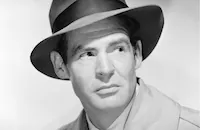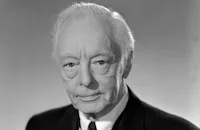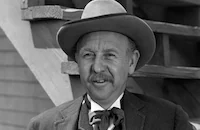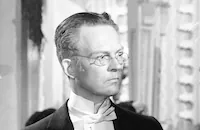Gangway for Tomorrow

Brief Synopsis
Cast & Crew
John H. Auer
Margo
John Carradine
Robert Ryan
Amelita Ward
William Terry
Film Details
Technical Specs

Synopsis
Jim Benson, the driver of a car carrying five defense workers to an aircraft manufacturing plant, invites his passengers home for dinner Sunday night and admits that he has made up fictional biographies about each of them in response to his wife's questions. Benson's story about Lisette, a French woman, triggers haunting memories of why she came to the United States: In Paris, during the war, Lisette used her work as a cabaret singer to hide her activities in the French underground. When Lisette and her freedom-fighter friends use a secret radio transmitter to interrupt Hitler's broadcast with a rendition of the "Marsellaise," a German colonel recognizes Lisette's voice, and she is arrested with the other members of her group. Betrayed by one of their own, the group is sentenced to die in front of a firing squad. After she accepts her life in exchange for entertaining the German troops, Lisette is loaded on a truck bound for prison. Lisette jumps from the rear of the truck, and returns to the radio transmitter where she broadcasts a warning about the traitor in their midst and memorializes her martyred friends. Coming out of her reverie, Lisette explains to Benson that after escaping from France, she came to America because her father was an American and she wanted to aid the war effort in any way possible.
Soon after Lisette finishes her story, Benson's car tire goes flat, and as the other passengers wait alongside the road, fellow defense worker Joe Dunham changes the tire. As he works, Joe remembers his pre-war life as a race car driver: Joe, who is planning to join the Air Corps after completing the Indianapolis race, is leading in the last lap when his tire blows and he loses control of his car. In the ensuing accident, Joe suffers injuries which render him ineligible for military service. His thoughts returning to the present, Joe finishes changing the tires, and the others climb back into the car.
The budding comraderie of his fellow passengers prompts Tom Burke to worry that he may have to recount his story: Before the war, Burke is a prison warden whose duties force him to supervise the execution of his younger brother, Dan Barton, an incorrigible criminal. As the hour of Dan's execution approaches, Burke reflects back to a year earlier, when he asked his brother to leave town before their mother discovered that her youngest son was a criminal. Dan defies his brother's request, and when their mother sees a newspaper headline identifying her son as the gunman who killed four men during a bank robbery, she dies, clutching Dan's photograph in her hand. Burke escorts Dan to the electric chair and is about to pull the switch when the phone rings. Ignoring the ringing phone, Burke electrocutes his brother and then answers the call from the governor pardoning Dan. Burke's thoughts return to the present when Wellington, another passenger in the car, asks him what he did before the war and he answers that he was in the legal business.
Benson's description of passenger Mary Jones as a "nice, pretty home girl" prompts her to think back to the triumphant night she won the Miss America pageant. No longer Miss Jones but Miss America, Mary foresakes her boyfriend, Bob Nolan, for her career. When Bob proposes, Mary insists upon postponing any thought of marriage until after she has completed her reign, and sets out to find fame in New York. Promised three song and dance numbers in a Broadway show, Mary sees her part reduced to a walk-on. Brokenhearted, Mary receives a letter from Bob, notifying her that he has enlisted in the Air Corps and is stationed in Australia. Benson's question about her boyfriend brings Mary back to the present, and she answers that he is still in Australia.
Benson's description of Wellington as an ex-banker prompts Wellington to reminisce about his travels as an erudite hobo. Arrested for vagrancy, Wellington is chastised by Judge Fred Taylor for failing to come to the defense of his country. Inspired by the judge's words, Wellington goes to work at the aircraft factory. As Wellington's thoughts return to the present, Benson's car arrives at the factory, and after agreeing to meet for dinner on Sunday, the workers link arms and enter the plant to the strains of "The Battle Hymn of the Republic."

Director
John H. Auer
Cast

Margo

John Carradine

Robert Ryan
Amelita Ward
William Terry

Harry Davenport
James Bell

Charles Arnt
Alan Carney

Wally Brown
Erford Gage
Richard Ryen

Warren Hymer

Michael St. Angel

Don Dillaway
Sam Mcdaniel
John Wald
Leon Belasco

Gene Gary
Louis Donath
Bruce Edwards
Carole Gallagher
Wheaton Chambers

Hope Landin
Earle Hodgins
Anne Kunde
Theron Jackson
Al Kunde
Al Ferguson

Elaine Riley

Rita Corday
Margaret Landry
Robert Anderson

Richard Martin
Ida Shoemaker
Jacques Lory
Alex Papana
Billy Roy
Louis Arco
Major Farrell
Carl Ekberg
Egon Brecher
Dave Thursby
George Jackson
Gus Glassmire
Bert Moorhouse
George Carleton
George Ford
David Newell
W. R. Deming
Angelo Desfis
Kernan Cripps
Eddie Borden
Paul Lacy
Blanche Webb
Ben Watson
Charles Marsh
George Magrill
Harry Tenbrook
Lynton Brent
Bill Oakley
William J. O'brien
James Farley
Bob Thom
Dick Rush
Leroy Strine
Frank O'connor
Bob Evans
Josh Milton

Claire Mcdowell
Babe Kane
June Booth
Lillian Elliott
Edmund Glover
Robert Bice
Edythe Elliott
Hooper Atchley
Don Kerr
John Sheehan
Noelle Delorme
Frederick Brunn
George Melford
Chester Carlisle
Brandon Beach
Jack Raymond
Peggy Miller
Patti Brill
Gerald Pierce
Bruce Cameron

Harro Meller
Harry Clay
John Bohn
Crew
John H. Auer
C. Bakaleinikoff
George Crone
Albert S. D'agostino
Bailey Fesler
Al Herman
Aladar Laszlo
Dixie Mccoy
Nicholas Musuraca
Arch Oboler
Lloyd Richards
Darrell Silvera
William Stevens
Edward Stevenson
James G. Stewart
Vernon L. Walker
Roy Webb

Film Details
Technical Specs

Articles
Gangway for Tomorrow
Gangway for Tomorrow is one such movie, following in flashback the back stories of five defense plant workers. As they travel to their jobs in a single car, each tells what brought them to their present positions: a race car driver rendered ineligible for service after a bad crash, a former Miss America whose quest for fame came to naught, a prison warden who quit his job after having to execute his own brother for murder, an erudite hobo shamed by a judge into supporting the war effort, and a French cabaret singer who fled her homeland after her arrest for resistance activities against the Nazis.
The working title of the film was "An American Story," rather more appealing than the final release title, which sounds almost like a parody of an old Hollywood film and perhaps betrays the intentions of its studio, RKO, to give this no more than B picture treatment.
Mexican-born Margo was given top billing as the most recognizable name in the cast, having appeared previously in the prestige screen production of Maxwell Anderson's stage hit Winterset (1936), the Shangri-La fantasy drama Lost Horizon (1937), and The Leopard Man (1943), one of Val Lewton's evocative horror pictures for the studio. This was her last picture for five years after marrying actor Eddie Albert (later of TV's Green Acres). When she returned to the screen in the late 40s, she worked sporadically over the following 15 years or so, mostly in television, before living out the last 20 years of her life in retirement.
Most of the cast is either relative unknowns or popular character actors like Harry Davenport and second-billed John Carradine, doing a Barrymore-like turn as the "heaubeau" (as his character posits), one of many memorable supporting roles he performed in his roughly 60-year career.
As the race car driver longing for action on the front lines, Robert Ryan was not yet the name he would become in his long run as one of Hollywood's most respected actors, despite being cast mostly in heavy roles. His star was beginning to rise at RKO with six pictures released by the studio in 1943, including the war-themed Bombardier and Behind the Rising Sun, which also starred Margo. Just a couple of months after Gangway for Tomorrow was released, Ryan enlisted in the Marines for the duration of World War II. When he returned to Hollywood in 1947, he became a key figure in the film noir genre that took hold after the war, with starring roles in such films as The Woman on the Beach (1947), Crossfire (1947), Born to Be Bad (1950), and On Dangerous Ground (1951). Ryan continued to create memorable roles right up to his death, making his final appearance in a film adaptation of Eugene O'Neill's The Iceman Cometh (1973).
The screenplay was only the second credit for Arch Oboler, who was critically praised for the dramatic techniques he brought from his stint as a radio writer, director, producer, and host.
An item in the Hollywood Reporter during production of this film noted that the studio was able to cut costs considerably by having the studio gate and machine shop stand in for the defense factory in the story.
Director: John H. Auer
Producer: John H. Auer
Screenplay: Arch Oboler, from an original story by Aladar Laszlo
Cinematography: Nicholas Musuraca
Editing: George Crone
Art Direction: Albert S. D'Agostino, Alfred Herman
Original Music: Roy Webb
Cast: Margo (Lisette Rene), John Carradine (Wellington), Robert Ryan (Joe Dunham), Amelita Ward (Mary Jones), James Bell (Tom Burke), Harry Davenport (Fred Taylor)
By Rob Nixon

Gangway for Tomorrow
Quotes
Trivia
Notes
The working title of this film was An American Story. A Hollywood Reporter production chart credits Les Milbrook as editor, but his participation in the completed film has not been confirmed. This was producer-director John Auer's first production for RKO. According to a news item in Hollywood Reporter, the studio saved building material and labor by using the studio gate and machine shop as the setting for the factory in the film. The Motion Picture Herald review commented that screenplay writer Arch Oboler, a prominent radio writer, employed radio dramatic techniques to great advantage in this film.














